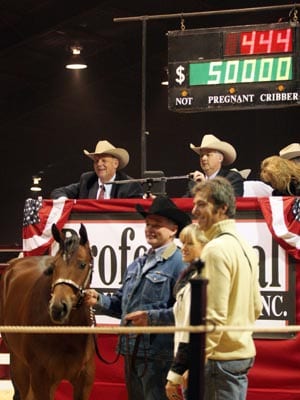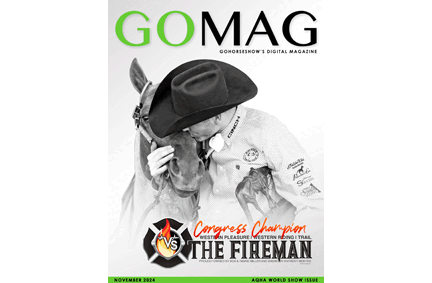Here are a few tips to help you prepare your horse for auction so he will earn top dollar.
By Cathy Jennings, Professional Auction Services
Ever wonder why some people consistently get top dollar for their horses at sales and others are just as often crying the blues?
Is it because one always brings better horses than the other? Not necessarily. Really good horses can and do slip through the cracks at auctions because of lack of preparation.
“In most cases, this is the biggest competition that your horse will ever be in,” says Tim Jennings of Professional Auction Services, which manages a number of large horse auctions, including the AQHA World Show Sale, November 17-18 in Oklahoma City. “You are competing for buyers’ dollars against all of the other horses in the auction. And the prize is the price you get for your horse.”
Getting the most money for your horse at auction requires careful planning. You cannot just go pull “Ole Buck” out of the pasture, give him a bath and expect others to appreciate what you see in him. It takes time and effort to get your horse fit and ready to sell.
Tim offers some tips that have consistently worked for him and his customers: If the auction is in the fall, get your horse into a barn, stall or shed no later than mid-August to have his hair right for the sale. You can use lights to make your horse’s body think that the days are longer than they really are, which will give him time to shed any burnt hair coat and will ensure that he keeps his coat slick and shiny for the auction.
- Make sure your horse is free of internal parasites. You should not start fitting a horse that is full of worms – he won’t look or feel good.
- Make sure his vaccinations are up to date and that he has a current Coggins test. If he doesn’t, be sure to get one well before the sale deadline.
- Assess his weight and adjust your feed program accordingly. Is he too thin? Does he have a grass belly, but no weight over his back? Is he too fat all over? Try to visualize what you want him to look like at the sale and go from there. Well-fed horses always sell better than thin horses. Grain puts weight on over a horse’s back. If you need more weight there, increase the grain. If your horse is getting too much gut, decrease the hay, or use an alfalfa and/or grass-mix hay. Look at the horse every day and make adjustments as needed.
- Put him on a regular shoe or trim program, if he isn’t already on one.
- Make sure your farrier is scheduled for one week to 10 days before the sale so your horse can adjust.
- Put your horse on a regular exercise or training schedule: If he is a halter horse, he needs to look like he is ready to “win the World.” If he is a performance horse, he needs to be performing to the best of his ability on the day of the sale. For a yearling longe liner or western pleasure/ hunter under saddle prospect, he needs to know how to perform on a longe line and in a round pen. The more well-trained he is, the better he will show at the sale and in the performance demonstrations. The better he does in these areas, the more money you will get for him.
- Regularly groom your horse. Scrub, vacuum and brush, brush, brush!
- Do not comb tails – handpick them or just wash and condition them.
- Desensitize your horse – take him to as many places as possible:
your neighbor’s house, on trail rides, anywhere that exposes him to new
things if he has never been anywhere. This will make it much easier for
him to settle in at the sale. - Make sure you have satisfied all the health requirements for the
sale in the proper time frame. Be certain that all your paperwork is in
order and on file with the sale company. - Clip
ears, bridle path, muzzle, jaw and fetlocks the day before you leave
for the sale. Do not leave that for when you arrive. Remember, there are
potential buyers from the minute you unload your horse. You can always
do touch ups at the sale. - Arrive early at the sale. Give your horse plenty of time to acclimate himself to his new surroundings.
- Put finishing touches on after you get to the sale – braid an English horse’s mane, band a western or halter horse’s mane.
- Do not use training tack on a horse that is supposed to be finished.
- Make sure your horse, tack, stall area and, especially, you are spotless.
- Be available to talk to potential buyers about your horse. Be
friendly and honest about your horse. Answer all questions to the best
of your ability.
Doing all of these things doesn’t guarantee a big price for your
horse, but it will definitely increase your chances. In today’s market,
it is too easy to move on to the next horse. Yours must have something
about him that makes that buyer stop and take that second look. Yes, you
have to have the right product, but you have to present that product in
a way that will make someone want to buy it, above all the others.
Preparation is the key.








